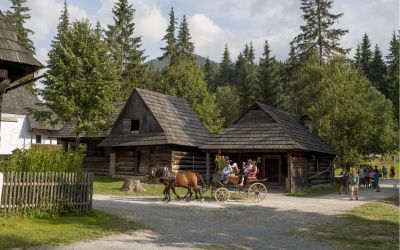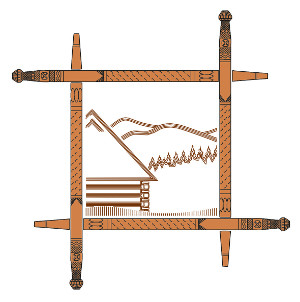THE TRAIL OF VILLAGES under the Wallachian law

Opis produktu
TYPE OF THE ROUTE: car route
LENGTH OF THE ROUTE: approx. 220 km
THE ROUTE:
Čičmany – Stará Bystrica – Terchová – Oravská Polhora– Zuberec
DESCRIPTION OF THE ROUTE:
The proposed route leads through villages located under the Wallachian law.
Čičmany
The southernmost village of the district of Žilina. Čičmany was first mentioned at the end of the 13th century.
At that time, the village belonged to the Turócziovcov, Rakovskovcov, Jesenskovcov, then to Kubínyiovcov and Serényiovcov. The village was probably founded under Wallachian law, as evidenced by shepherd’s chalets, folk
costumes and customs. In addition, in the past, the inhabitants of Čičmás used to be engaged in sheep farming and bryndza(traditional rennet cheese) production in addition to agriculture. Today, Čičmany is a winter sports centre with several ski lifts.
In Čičmany it is worth visiting the Baroque Church of the Holy Cross from the end of the 18th century. In addition, the main attraction of the village is its buildings; the traditionally erected buildings have unique white ornamentation. In the 70s of the 20th century 136 houses were under conservation protection. There is a museum in the village, tourists can visit the permanent exhibition in the Radenov house and the house numer 42.
In the past, the village was famous for its slippers, and the local embroidery is distinguished by its technical perfection and a wealth of decorative motifs and compositions. Although Čičmany is a small town with 131 inhabitants, it has accommodation and catering facilities.
Stará Bystrica
The village is situated in the eastern part of the Čadca district, on the border of the Beskid Kysucki and Kysucké
Peaks, it is one of the oldest villages in the region. Sources indicate that the village was located under Wallachian law, and the first written records date back to 1590.
One of the main attractions of the village is the astronomical clock, which was completed in 2009. The clock was integrated into the wooden, richly ornamented and carved facade of the building, becoming at the same time the largest wooden statue in Slovakia. The author, Viliam Loviška, showed a stylized figure of Our Lady of Sorrows, in which the clock is inscribed.
There is also the Church of St. Michael the Archangel, consecrated in 1892. Inside there are nearly 50 images of
angels.
Above the village there is a 17-metre-high stone lookout tower on the Bobovec hill, which is located about 1.5 hours walk from the centre of the village.
The village also offers a wide range of opportunities for active recreation - there is a cycling route and numerous hiking trails.
Terchová
A village located under Wallachian law in 1580, known for its modern cultural event - Janosik’s Days. The village
was the seat of the Wallachian princes. Many times in history, unfavourable circumstances forced a large part of the population to migrate in order to seek better living conditions in the southern regions of Slovakia. The whole village is strongly connected with the local hero, Juraj Janosik, who was born here. Janosik and his life were devoted to permanent exhibitions in the museum, which were divided into thematic units: traditional housing, Janosik as a local hero of folklore, tradition and crafts. A symbolic house was opened in the place where the highland robber was born.
The village is situated in the National Park Malá Fatra, making it an ideal place for nature lovers, walks and hikes.
Oravská Polhora
A border village located in the north of Orava. The first mention of the village’s location dates back to 1550 and
has the form of a map showing the salt springs under Babia Góra. The village was founded under Wallachian law and belonged to Juraj Turz. The name Polhora comes from the fact that its borders reached half of Babia Góra - the queen of the Orava Beskids. The main occupation of the inhabitants was once animal breeding and carving.
The inhabitants of Oravská Polhora, thanks to the location of the village and the temperament of the highlanders, have managed to preserve lively, unique, archaic forms of music, singing and dancing. The village is known for its gajd culture (a traditional musical instrument), which was inscribed on the UNESCO list of intangible heritage in 2015.
The springs of salt water, located in the former Slaná Voda bathhouse, are worth a visit. It is a water with a high
iodine content, intended for therapeutic baths, once known and exported to various parts of Europe.
The area of the village belongs to the Horná Orava Protected Landscape Area, which proves countless natural
attractions. There are several protected peat bogs with rare and endangered plant species. The most famous peat bogs are: Polhorská Píla, Rašelinisko Tisovnica and Slaná Voda.
An important event in the village is the Gajdovačka festival, which promotes the gajd culture, in which more than 100 performers from different parts of the world participate. As part of the “Wallachian Cultural Route” project, the municipality renovated the former customs office building and opened a pastoral centre, a museum and an information centre in a unique space. The building will also host exhibitions,
seminars and conferences on Wallachian culture.
Zuberec
The village is located on Upper Orava in the district of Twardoszyn, in the immediate vicinity of the Western Tatras. The first written references about the village date back to the end of the 16th century (1593) and are related to the foundation of the village under Wallachian law, as a result of colonization efforts of the Turzovcov family. Zuberec is situated directly below Roháčmi, which are alpine in character, and next to their ridges there was an intensive pastoral activity. Information from the 17th century shows that a total of 7985 sheep were grazed in 18 municipalities near Zuberca in 1615. In order to increase the area of pastures, shepherds burned pine forests, as a result of which several valleys were created. The names Spálená and Spálený žľab are testimony to this.
While in Zuberec it is worth visiting the Orava Village Museum, where there are about 50 buildings grouped together to show the diversity of Orava architecture. There is also a wooden Gothic church of St. Elizabeth of Hungary from the 15th century.
For active people it is recommended to follow the educational trail around the Rohac lakes, where you can admire the unique flora and fauna.
Dodatkowe informacje














